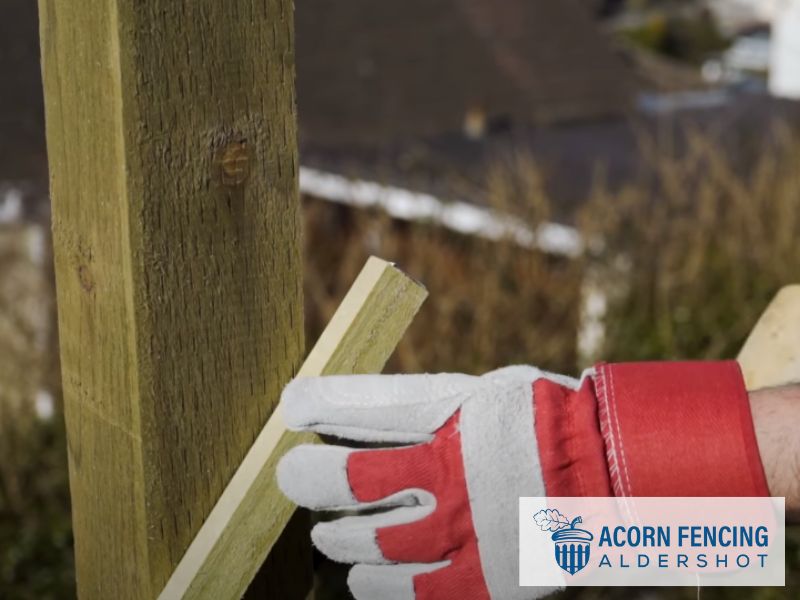Improperly spaced fence posts can lead to a weak structure vulnerable to damage from weather, animals, and general wear and tear. Determining the optimal distance between fence posts is crucial for building a sturdy, long-lasting barrier around your property. Seeking advice from experienced fence contractors Aldershot can provide valuable insights into the appropriate spacing of fence posts, ensuring the structural integrity and durability of your fencing project.
Factors Influencing Maximum Distance
Type of Fence Material
- The type of material used for the fencing plays a key role in determining necessary post spacing. Heavier materials like wood require posts placed closer together while lighter vinyl and metal can allow slightly wider gaps. Always check manufacturer specifications.
- Wooden fences typically need posts every 1.8-3 meters. Vinyl and metal fence materials generally require 3-3.6 meter post spacing, but taller heights may need narrower gaps.
Fence Height
- Post spacing must account for the fence’s height and susceptibility to wind resistance. Taller barricades and panels catch more wind, exerting greater pressure on the framework.
- Shorter ornamental fences up to 1.2 meters tall can accommodate up to 3 meter gaps. Standard 1.8 meter heights perform well at 2.4-3 meter intervals. For safety and stability, taller 2.4 meter fences should limit posts to no more than 2.4 meters apart.
Purpose of the Fence
- The fence’s intended function also impacts ideal post distance. Security fences and barriers protecting property lines may need evenly-distributed posts at short intervals for optimal stability. The stakes also make digging underneath difficult.
- Strictly decorative garden fences can allow slightly wider spacings focused on aesthetics over function. However, don’t sacrifice too much stability. Collision with yard equipment is also a risk with posts spaced too far apart.
UK Regulations and Standards
Building Regulations
- All fences over 1 meter in height must comply with UK building regulations. Relevant guidelines emphasize proper spacing dimensions based on material and purpose to meet safety standards.
- If you plan to sell the property down the road, carefully follow the regulations to avoid issues. If desired post spacing differs significantly from guidelines, consider consulting your local authority.
British Standards for Fencing
- Adhering to British standards published by BSI ensures optimal construction for security, agricultural, temporary, and other common fence types. This contributes greatly to overall performance and longevity.
- For example, steel mesh and chain link fences must follow BS 1722 Part 10 standards under most circumstances with post spacing specifically covered. Timber fences fall under BS 1722 Part 5.
Calculating Maximum Distance
General Guidelines
- Basic formulas provide starting guidelines: multiply the fence height by 0.6 meters if wood or 0.9 meters for other popular materials. However, consider modifying based on fence load capacity and exposure to wind conditions.
- Corner posts and ends of fence runs require shorter spacing than central sections for increased support. Reduce spacing between both corner/end posts and adjacent line posts.
Online Tools and Resources
- Specialized calculators like those from Jacksons Fencing can provide tailored guidance on post spacing by entering details on fence height, terrain, materials, and purpose.
- Resources like the AGS Roadmap offer additional standards to inform appropriate distances in tricky installations like slopes. Always cross-reference multiple credible sources.
Frequently Asked Questions
What is the standard post spacing for a wooden fence in the UK?
The optimal post spacing for wooden fences ranges between 1.8-3 meters based on height and environment. British standards often recommend placing posts every 2.4 meters for stability. Reduce spacing for taller fences and high-wind areas.
Can I use the same post spacing for all types of fences?
No, the maximum post distance must differ based on the fencing material used and the structure’s size. Lightweight vinyl and metal can allow slightly longer spans than wood but still have limits, especially in taller barricades. Always tailor spacing to the specific fence.
Are there any exemptions to the standard regulations?
Building codes and British standards aim to cover most residential fence construction. However, if justified, you can submit spacing plans which deviate from the guidelines to your local authority for approval based on need and engineering specifications.
How deep should fence posts be buried in the UK?
For optimal stability, wooden and metal fence posts should be buried at a depth equal to one-third the total height above ground. So a 1.8 meter post requires 0.6 meter depth underground. Deeper installation provides increased protection against frost heave over time.
What are the consequences of improper post spacing?
Posts placed too far apart lead to insufficient structural support, causing the fence to lean, sag, and become vulnerable to collapse. This also shortens the usable lifespan compared to proper spacing. Be sure to get distances right at the build stage to avoid headaches down the road.
Thanks for reading our post, feel free to check out our other services:











